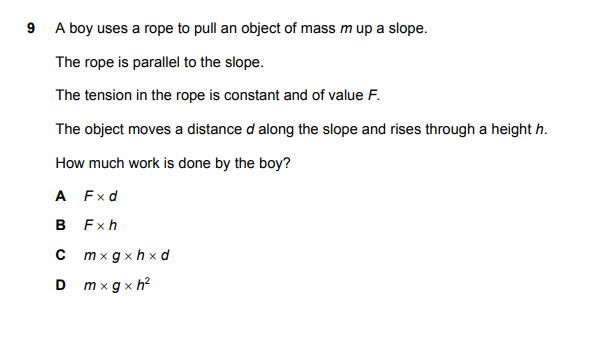A boy uses a rope to pull an object of mass m up a slope. The rope is parallel to the slope. The tension in the rope is constant and of value F. The object moves a distance d along... A boy uses a rope to pull an object of mass m up a slope. The rope is parallel to the slope. The tension in the rope is constant and of value F. The object moves a distance d along the slope and rises through a height h. How much work is done by the boy?

Understand the Problem
The question describes a scenario where a boy pulls an object up a slope using a rope. The goal is to determine the amount of work done by the boy in terms of the force (F), distance (d), mass (m), gravity (g), and height (h).
Answer
A $F \times d$
Answer for screen readers
A $F \times d$
Steps to Solve
- Recall the definition of Work
Work is defined as the force applied to an object multiplied by the distance the object moves in the direction of the force.
- Apply the formula
In this case, the force applied by the boy is $F$, and the distance the object moves along the slope is $d$. Therefore, the work done by the boy is given by: $W = F \times d$
A $F \times d$
More Information
The work done only considers the force applied and the distance over which the force is applied in the direction of the force. The height $h$ is not directly used in calculating the work done by the boy in this scenario, although it is related to the change in potential energy of the object.
Tips
A common mistake is to confuse the work done by the boy (due to the tension in the rope) with the change in gravitational potential energy of the object (which would involve $m$, $g$, and $h$). The question specifically asks for the work done by the boy, which is directly related to the tension $F$ and the distance $d$.
AI-generated content may contain errors. Please verify critical information